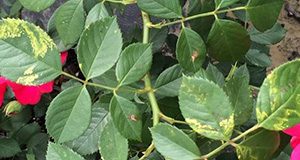Rose mosaic virus disease is one of the most economically important diseases affecting roses, because a single symptomatic leaf can result in the rejection of complete shipments for wholesale or retail rose producers. It continues to be a problem in nursery production and landscapes. This 5-page document discusses the causes, symptoms, and management of this disease. Written by Susannah da Silva, Binoy Babu, Mathews L. Paret, Gary Knox, Fanny Iriarte, Barron Riddle, Matt Orwat, Shawn T. Steed, E. Vanessa Campoverde, and Svetlana Y. Folimonova and published by the UF/IFAS Plant Pathology Department, August 2018.
http://edis.ifas.ufl.edu/pp338
Tag: Binoy Babu
“Candidatus Liberibacter solanacearum”: An Emerging Pathogen Infecting Potato and Tomato

A bacterium called “Candidatus Liberibacter solanacearum” infects potatoes and tomatoes, causing zebra chip in potatoes and psyllid yellows in tomatoes. These disease are highly destructive and have been known to reduce yields by up to 85%. “Ca. L. solanacearum” has been reported in several states, though it has not been detected in Florida, which is the second largest producer of tomatoes and seventh largest producer of potatoes in the US. This 9-page fact sheet covers the biology, distribution, symptoms, transmission, diagnosis, and management of the pathogen and its associated diseases. Written by Binoy Babu, Mathews L. Paret, Nicholas Dufault, and Carrie L. Harmon, and published by the UF Department of Plant Pathology, August 2015.
http://edis.ifas.ufl.edu/pp320
Rose Rosette Disease: A New Disease of Roses in Florida
Rose rosette disease is an incurable, destructive disease that affects both wild and cultivated roses. Over the past several decades, the disease has spread over much of the U.S., though it was first observed in Florida in 2013. This 6-page fact sheet describes the symptoms and diagnosis of the disease, as well as the cultural, chemical, and, possibly, biological controls that can minimize its spread. Written by Binoy Babu, Mathews L. Paret, Tim Schubert, Carlye Baker, Gary Knox, Fanny Iriarte, James Aldrich, Laura Ritchie, Carrie L. Harmon, and Svetlana Y. Folimonova, and published by the UF Department of Plant Pathology, May 2015.
http://edis.ifas.ufl.edu/pp317

